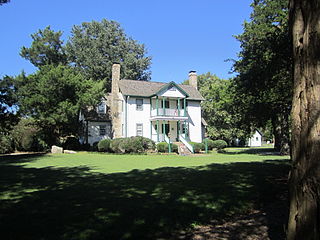
The Bennett Bunn Plantation is a historic farm near Zebulon, North Carolina, a suburb of Raleigh. The plantation, located beside US 264 in eastern Wake County, consists of a two-story house, built in 1833, barns, and 162 acres (66 ha) of farmland and forests. The property was owned by generations of the Bunn family until 2000 when Grace Hutchins, great-granddaughter of Bennet Bunn, sold the property for $1.9 million. The home is still used as a private residence and was listed on the National Register of Historic Places in February 1986.
The Meadows, also known as the Robert Carter Hilliard House, is a historic plantation house located near Battleboro, Nash County, North Carolina. It dates to the early-19th century, and is a two-story, five bay by two bay, Federal style dwelling with a one-story rear shed addition. It is sheathed in weatherboard, a low-pitched gable roof, and double-shoulder exterior end chimneys. The front facade features a one-story replacement porch covering the center three bays.

Nuckolls-Jefferies House, also known as the Nuckolls House and Wagstop Plantation, is a historic plantation house located near Pacolet, Cherokee County, South Carolina. It was built in 1843, with alterations in the 1870s or 1880s. It is a 2+1⁄2-story, frame residence in a combined Greek Revival / Classical Revival style. It is clad in weatherboard and sits on a stone foundation. The front facade features a two-tiered central, pedimented portico supported by two sets of slender wooden posts. The rear of the house has a two-story ell, built during the 1996 restoration. Also on the property are three contributing outbuildings: a small, one-story log gable-front building that dates from the mid-to-late 19th century that served as the farm's smokehouse, a 1+1⁄2-story gable-front frame barn, and another frame gable-front barn with side shed lean-to extensions.

Albion is a historic plantation house located near Blackstock, Fairfield County, South Carolina. It was built about 1840 by a wealthy planter named Alexander Douglas.
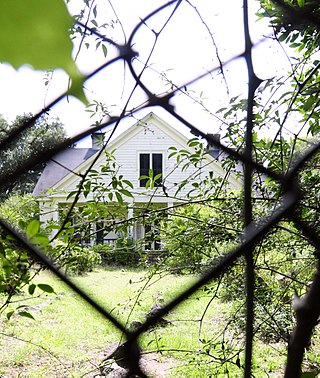
Balwearie is a historic plantation house located near Winnsboro, Fairfield County, South Carolina. It is a 1+1⁄2-story, brick and frame residence with a gabled roof and cross-gabled front porch. The first story is of brick construction; half-story is sheathed in weatherboard. The front gable is supported by six paneled wooden posts. The house was constructed about 1822, but altered following an 1886 storm. A rear porch was converted into a kitchen in 1975.

Bracebridge Hall is a part of historic farm, the house is part of a former former plantation and is a registered national historic district located near Macclesfield, Edgecombe County, North Carolina. The district encompasses eight contributing buildings, two contributing sites, and three contributing structures associated with the Bracebridge Hall. The original house was built about 1830–1832, and enlarged about 1835–1840, 1880–1881, and 1885. It is a two-story, five bay, weatherboarded frame dwelling with Greek Revival and Victorian style design elements. It features a one-story Doric order portico. Also on the property are the contributing Metal boiler/basin, Plantation Office, Servants’ House, Tobacco Barn, Troughs, Large Barn, Barn, Overseer's House, Carr Cemetery (1820), and the Agricultural landscape. Buried in the cemetery is North Carolina Governor Elias Carr (1839-1900) and his wife Eleanor Kearny Carr (1840–1912).

Rountree Family Farm, also known as the Alfred Patrick Rountree Farm, is a historic farm complex located near Gatesville, Gates County, North Carolina. The property consists of the property, buildings and outbuildings constructed by four generations of the descendants of Abner Rountree who acquired the family's original holding here in 1800. The Simmons Rountree House was built about 1830, and is a two-story, one-room plan frame house. It has not been occupied as a residence since 1907. The Alfred Patrick Rountree House was built in 1904 and expanded about 1916. It is a two-story frame farmhouse sheathed in weatherboard. Also on the property are the contributing dairy, hand-pump, wood shed, smokehouse, privy, three barns, stable, and chicken coop.
Model Farm, also known as Swarthmore Farm, is a historic home located at High Point, Guilford County, North Carolina. It was built about 1867, and is a 2+1⁄2-story, triple-A roofed, side-gabled, L-plan, frame building with 12 rooms. It is sheathed in weatherboard and sits on a brick foundation. The front facade has a full width, one-story hip-roofed porch. The house is associated with an important program of the Quakers to improve agricultural endeavors in the South in the decades after the American Civil War.
Lebanon is a historic plantation house located near Dunn, Harnett County, North Carolina. It was built about 1824, and is a two-story, three-bay, Greek Revival style frame dwelling with a one-story wing. It is sheathed in weatherboard and rests on a brick foundation. The front facade features a three-bay, two-tier porch. During the American Civil War, the Battle of Averasboro occurred in the immediate vicinity of plantation house and it was used as a hospital.
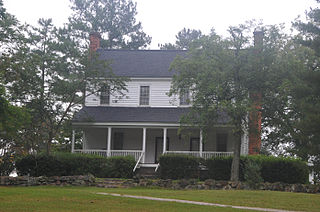
Puppy Creek Plantation, also known as the McGregor-Lamont House, is a historic plantation house located near Rockfish, Hoke County, North Carolina. It was built about 1821, and is a two-story, three-bay, Federal style frame dwelling. It is sheathed in weatherboard, has a gable roof, and sits on a high brick pier foundation. It features exterior end brick chimneys and full-width front porch.

Eagle Nest is a historic plantation house located near Pink Hill, Jones County, North Carolina. It was built about 1800 and is a two-story, four-bay by three-bay, Federal style frame dwelling. It rests on a brick foundation, is sheathed in weatherboard, and has a gable roof with exterior end chimneys. It has two one-story frame rear additions. The front facade features a two-tier engaged porch with an enclosed east end. Also on the property is a contributing smokehouse.

Welsford Parker Artz House, also known as Catawba Hill and Artz House, is a historic home located near Old Fort, McDowell County, North Carolina. It was built between 1904 and 1906, and is 2+1⁄2-story, five-bay, frame dwelling with Queen Anne and Colonial Revival style design elements. A small, one-story, gabled ell was added between 1912 and 1928. The house is sheathed in weatherboard and a moderately pitched, asphalt shingled roof with a dominant front gable and one-story wraparound front porch.
Belvidere Plantation House, also known as the Merrick-Nixon House, is a historic plantation house located near Hampstead, Pender County, North Carolina, US. It was built about 1810 for slaveholder George Merrick, and is a 1+1⁄2-story, three-bay, gambrel-roofed dwelling with Georgian, Federal, and Greek Revival style design elements. It is sheathed in weatherboard and has exterior end chimneys and a shed-roofed front porch.
Mount Vernon is a historic plantation house, farm complex, and national historic district located near Woodleaf, in Scotch Irish Township, Rowan County, North Carolina. The house was built about 1822, and is a two-story, three-bay, Federal style frame dwelling. It is sheathed in weatherboard and has a full-width, one-story shed roofed porch. The house was designated a post office in 1822. Also on the property are the contributing log smokehouse, large barn, "lighthouse" or Delco house, corn crib, gear house, woodhouse, spring house, mill site, shop, and plantation office.

Carrier Houses, also known as the Carrier-Ward House and Carrier-McBrayer House, are two historic homes located near Rutherfordton, Rutherford County, North Carolina. The Carrier-Ward House was built in 1879, and is a two-story, weatherboarded, side-gabled Queen Anne-style frame house. It has a front projecting wing and a three-story square tower with pyramidal roof. The Carrier-McBrayer House was built about 1835, and is a transitional Federal / Greek Revival style I-house with two-story ell. The weatherboarded house sits on a brick foundation.
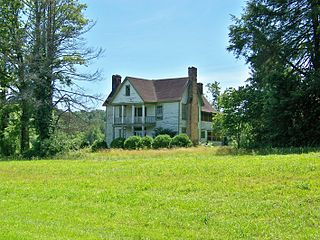
Flem Galloway House is a historic home and national historic district located near Calvert, Transylvania County, North Carolina. It was built in 1878, and is a two-story, heavy timber frame I-house, with a two-story rear ell. It is sheathed in weatherboard and has a gable roof. The front facade features a two-tiered, center-bay, cross-gabled porch. Also on the property is a contributing 1+1⁄2-story smokehouse.
Purefoy–Dunn Plantation is a historic plantation and national historic district located near Wake Forest, Wake County, North Carolina. The Greek Revival style plantation house was built about 1814 and remodeled about 1850. It is a two-story, L-shaped, heavy timber frame building. It has a low hipped roof and is sheathed in clapboards. The front portico was removed in the 1960s or early 1970s. Also on the property is a contributing mid-19th century gable-roofed frame smokehouse.
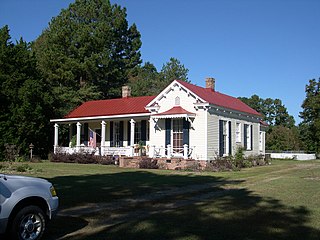
Olzie Whitehead Williams House is a historic home located near Wilson, Wilson County, North Carolina. It was built about 1860, and is a single-story, six-bay, "L"-shaped, Italianate style frame house with a gabled projecting end pavilion. It rests on a low brick pier foundation and is sheathed in weatherboard. The front facade features a shed roofed verandah.
Durrett-Jarratt House, also known as the Isaac Jarratt House, is historic plantation house located near Enon, Yadkin County, North Carolina. It was built about 1820, and is a large, two-story, four-bay, Federal style frame dwelling. It rests on a brick foundation, has molded weatherboard siding, a gable roof and exterior brick end chimneys. It has a mid-19th century shed roofed front porch, and dining room and kitchen additions. Also on the property is a contributing commissary building. The interior features original wood graining and decorative painting.
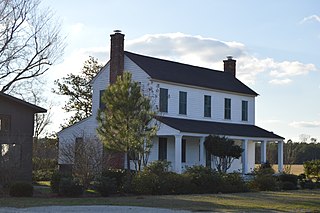
Black Rock Plantation House, also known as the Allen-Love House, is a historic plantation house located near Riegelwood, Columbus County, North Carolina. It was built about 1845, and is a two-story, five-bay, braced frame I-house with Federal / Greek Revival style interior design elements. The house is sheathed in weatherboard and has a gable roof. It has a rear shed roof addition and a replacement one-story shed roofed front porch. The house was renovated in 2013.
















